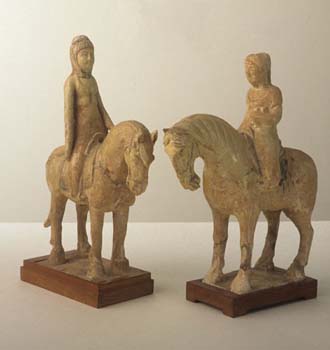Straw-glazed pottery equestrian figures: younger woman (A) and older woman (B)
- 7th century
- Artist unknown (Chinese), early Tang Dynasty
- Cast Ceramic
A: 32 x 9.9 x 25.9 cm., 12-5/8 x 3-7/8 x 10-3/16"
B: 31.4 x 10.2 x 26.1 cm., 12-1/4 x 4 x 10-1/4"- Catherine Carter Goebel, Paul A. Anderson Chair in the Arts Purchase in Honor of Cyrus and Mildred Churchill, Paul A. Anderson Art History Collection, Augustana College, 2007.24 a,b

Essay by Naoko Gunji, Former Assistant Professor of Art History
The two yellow-glazed pottery equestrian figurines, datable to the early Tang period (618-907), represent a change in women's roles and behaviors that were influenced by cultural exchanges, primarily from a surge of foreigners via the Silk Road into the cosmopolitan capital of Chang'an. According to Katheryn Linduff, the two equestrians were probably non-Han in origin from western China due to the fact that non-Han Chinese rode horses astride, while Han women in earlier times rode with both legs on one side of the horse side-saddle. Contrary to the Confucian gender hierarchy, many historical and visual sources attest that Tang women were not sheltered in their household but they went outside riding horses and playing polo (both of which are foreign in origin) with men. The costume of the equestrians also suggests female independent status affected by non-Han influence. Although the Augustana pieces epitomize female high social status and their high fashion costumes differ from those prior to the Tang dynasty, their function is deeply rooted in the long tradition of mortuary art. They are taoyong, the Chinese term, which refers to a pottery piece in a human form buried with the dead in the grave. These were buried with luxurious objects (i.e. bronze vessels and jade ornaments) that were either used by the deceased during his lifetime or were dedicated to him at his funeral. The provenance of the two mounted figurines in the Augustana College permanent art collection is undocumented, but several similar works were unearthed from the elite burials in Shaanxi province.
